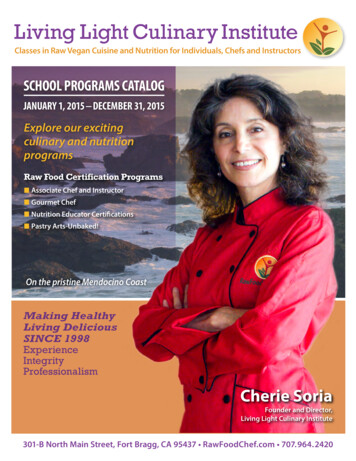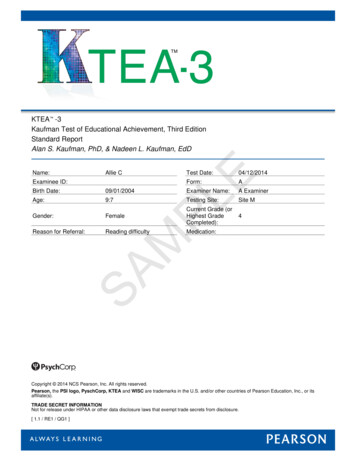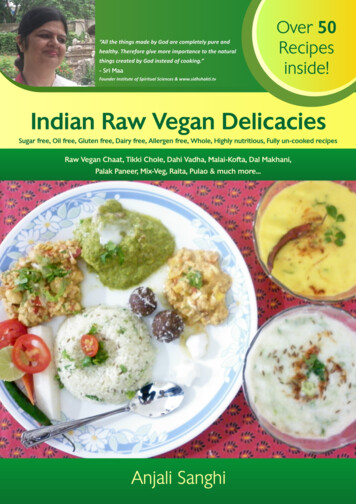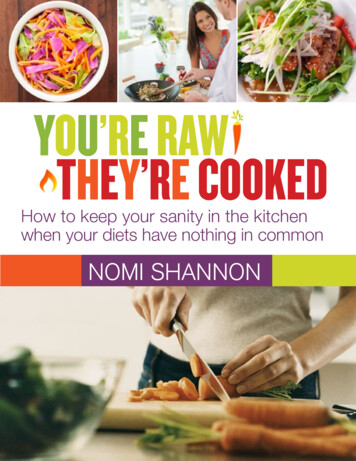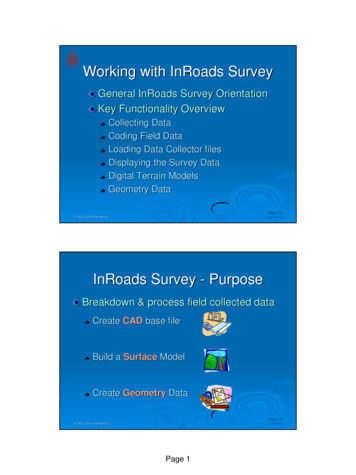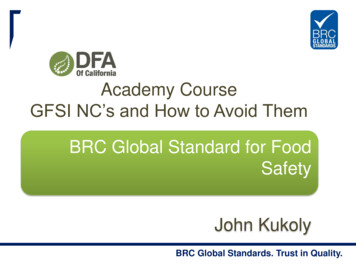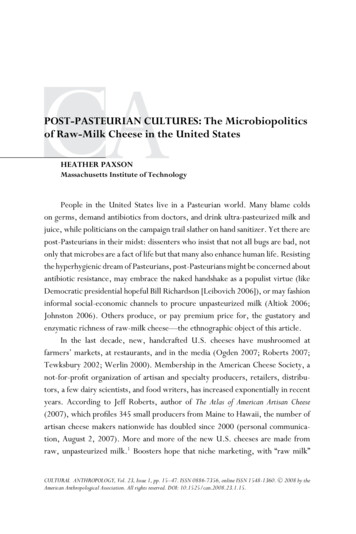
Transcription
CAPOST-PASTEURIAN CULTURES: The Microbiopoliticsof Raw-Milk Cheese in the United StatesHEATHER PAXSONMassachusetts Institute of TechnologyPeople in the United States live in a Pasteurian world. Many blame coldson germs, demand antibiotics from doctors, and drink ultra-pasteurized milk andjuice, while politicians on the campaign trail slather on hand sanitizer. Yet there arepost-Pasteurians in their midst: dissenters who insist that not all bugs are bad, notonly that microbes are a fact of life but that many also enhance human life. Resistingthe hyperhygienic dream of Pasteurians, post-Pasteurians might be concerned aboutantibiotic resistance, may embrace the naked handshake as a populist virtue (likeDemocratic presidential hopeful Bill Richardson [Leibovich 2006]), or may fashioninformal social-economic channels to procure unpasteurized milk (Altiok 2006;Johnston 2006). Others produce, or pay premium price for, the gustatory andenzymatic richness of raw-milk cheese—the ethnographic object of this article.In the last decade, new, handcrafted U.S. cheeses have mushroomed atfarmers’ markets, at restaurants, and in the media (Ogden 2007; Roberts 2007;Tewksbury 2002; Werlin 2000). Membership in the American Cheese Society, anot-for-profit organization of artisan and specialty producers, retailers, distributors, a few dairy scientists, and food writers, has increased exponentially in recentyears. According to Jeff Roberts, author of The Atlas of American Artisan Cheese(2007), which profiles 345 small producers from Maine to Hawaii, the number ofartisan cheese makers nationwide has doubled since 2000 (personal communication, August 2, 2007). More and more of the new U.S. cheeses are made fromraw, unpasteurized milk.1 Boosters hope that niche marketing, with “raw milk”C 2008 by theCULTURAL ANTHROPOLOGY, Vol. 23, Issue 1, pp. 15–47. ISSN 0886-7356, online ISSN 1548-1360. American Anthropological Association. All rights reserved. DOI: 10.1525/can.2008.23.1.15.
CULTURAL ANTHROPOLOGY 23:1and “artisanal” joining “organic,” might make cheese making a value-adding strategythat can save small dairy farms. Vermont dairy farms numbered 3,216 in 1983, theyear the American Cheese Society was founded; by 2003, only 1,459 remained.2Some of the most visible artisan cheese makers are early retirees launching a secondcareer with capital earned in lucrative professions (business, law) or are youngadults setting out to practice the lessons of sustainable development and critiquesof global agribusiness learned in liberal arts colleges. These producers tend to makehigh-end table cheeses that might sell in urban markets for as much as 27 a pound(retailers generally double wholesale prices). Many of the most experienced artisans are former hippies or back-to-the-landers who for decades have been craftingfarmhouse cheese for local markets and now suddenly find themselves part of anew “movement.” A growing number of farmstead cheese makers are dairy farmerswho turn raw, sometimes organic milk into Cheddar, Gouda, Jack, Feta, and other“everyday” cheeses that retail between 9 and 14 a pound (Paxson 2006). Not allartisanally produced cheeses appeal strictly to elite tastes and privileged incomes.All cheese producers face restrictions on getting raw-milk cheese to U.S.markets. By U.S. law (21CFR133.182), cheese made from raw milk must be agedat least 60 days at a temperature no less than 1.7 C (35 F) before being sold orimported. The 60-day rule means to offer protection against pathogenic microbesthat could thrive in the moist environment of a soft cheese. While the Food andDrug Administration (FDA) views raw-milk cheese as a potential biohazard, riddledwith bad bugs, aficionados see it as the reverse: as a traditional food processed forsafety by the action of “good” microorganisms—bacteria, yeast, mold—on proteinsfound in milk.This article proposes a theoretical frame for understanding current debatesover the gustatory value and health and safety of raw-milk cheese in the UnitedStates, debates that open into what Sidney Mintz identifies as a conundrum ofdemocratic capitalist societies: “how to provide protection to the citizenry on onehand, yet maintain freedom of choice on [the] other” (2002:27). I introduce thenotion of microbiopolitics to call attention to the fact that dissent over how to livewith microorganisms reflects disagreement about how humans ought live withone another. Microbiopolitics is one way to frame questions of food ethics andgovernance.If Foucault (1978) has argued that the 19th century saw the rise of biopolitics,the fashioning of new categories of persons to facilitate the statistical measurementand rational management of populations, largely via sex and reproduction, BrunoLatour, in The Pasteurization of France (1988), tracks a parallel history, describing the16
THE MICROBIOPOLITICS OF RAW-MILK CHEESEaccommodation of microbial life into the very constitution of this social field. Priorto Pasteur, Latour writes, Europeans had thought that butchers sold only meat,but then they discovered salmonella hitching a ride. It had been thought that birthinvolved but three players—midwife, mother, infant—but other agents were foundto be present (Latour 1988:35). Latour argues that with microbes revealed to becontrolled, hygienists, government officials, and economists laid the groundworkfor what they believed to be “pure” social relations—relations that would not bederailed by microbial interruption, that could be predicted and thus rationallyordered. Biopolitics, then, is joined by microbiopolitics: the creation of categories ofmicroscopic biological agents; the anthropocentric evaluation of such agents; andthe elaboration of appropriate human behaviors vis-à-vis microorganisms engagedin infection, inoculation, and digestion.3Pasteurian practices configure microbes as elements to be eliminated so thathuman polities might be cultivated. In addition to commercial food safety standards for refrigeration, pasteurization, and irradiation, examples include mandatorychildhood vaccination (first developed to combat anthrax in cattle [Salmon et al.2006]) and waterborne disease eradication (Nelson 2005). There is much to be commended in such public health programs. Raw milk can harbor the human pathogensSalmonella, Lysteria monocytogenes, Staphylococcus aureus, and Escherichia coli. Still,there are gaps in the hegemony of Pasteur’s “germ theory.” Although no one is suggesting overthrowing the FDA—a safe food supply is not to be underestimated—acurious mix of political libertarians and foodies is questioning some of the motivesand logics underpinning the Pasteurian food regime. Raw-milk activist and naturopathic physician Ron Schmid characterizes Pasteurian microbiopolitics this way:“Pasteur’s mechanistic understanding of disease took away the individual’s powerto prevent it, and placed the mandate to cure squarely in the hands of the medicalprofessionals” (2003:46). For Schmid, the “individual’s power” to prevent illnessfrom raw milk consumption includes not only careful production practices—milkfrom small herds of grass-fed cattle that never see a feed lot, for instance—but alsothe cultivation of diverse intestinal flora and fauna that could enable the consuminghuman body to protect itself from disease. Whereas Pasteurianism in the realmof food safety has suggested a medicalization of food and eating, post-Pasteurianswant to invest in the potentialities of collaborative human and microbial culturalpractices.The revival of artisan cheese making in the United States, especially ofaged raw-milk cheese, provides a window onto social and regulatory negotiations of a hyperhygienic Pasteurian social order (as forwarded by the FDA) and a17
CULTURAL ANTHROPOLOGY 23:1post-Pasteurian microbiopolitics. If Latour’s Pasteurians recognized microbes asfully enmeshed in human social relations, legitimating the hygienist’s right to beeverywhere, these post-Pasteurians move beyond an antiseptic attitude to embracemold and bacteria as allies. In the post-Pasteurian ethos of today’s artisanal cheesecultures—recognizing microbes to be ubiquitous, necessary, and, indeed, tasty—microbiopolitics is newly productive of modern craft knowledge and expandednotions of nutrition. It produces new materials (microbes) for thinking about conjunctures of cultural tradition and agrarian landscapes, along the lines of what theFrench call terroir (see Barham 2003; Trubek 2005). And it creates new alliancesamong cheese makers and among farmers, scientists, merchants, and foodies. In2000, the American Cheese Society joined with Oldways Preservation and Exchange Trust to form the Cheese of Choice Coalition, dedicated to protectingAmericans’ right to eat raw-milk cheese. Through such networks, raw-milk cheesebecomes legible as part of an alternative agrofood movement that works through“support for an alternative technology and/or product, as well as associated policies, production practices, and research programmes, that generally involves botha mobilization of civil society organizations and the formation of alliances withprivate sector organizations” (Hess 2004:494). Whereas Pasteurianism creates incitizens expectations that the state will ensure a safe food supply, such that “foodpanics” throw into doubt “the state’s ability to regulate business and bodies” (Dunn2007:36), post-Pasteurianism questions whether state regulators have only theinterests of citizen-consumers at heart.Microbiopolitics, then, is not about using molecules as metonyms for individual or population characteristics (race, disability).4 Rather, it concerns therecognition and management, governmental and grassroots, of human encounterswith the vital organismic agencies of bacteria, viruses, and fungi. Placing microorganisms such as bacterial cultures and cheese mold at the center of accounts of foodpolitics can show us how public understandings and appropriations of scientificknowledge are reshaping how people think about food, its production, its nutritional and cultural value, and the regulation of its safety (e.g., Nestle 2003). Thisapproach extends the scaling of commodity-network analyses in agrofood studiesbeyond global–local trajectories (Barndt 2002; Friedberg 2004; Jarosz 2000) andinto the body, into the gastrointestinal. Philosophers of biology Maureen O’Malleyand John Dupré have written, “We believe that an indefensible focus on macrobes[multicellular eukaryotes] has distorted several basic aspects of our philosophicalview of the biological world” (2007:156). I suggest that neglect of the microbe(any organism, in the singular, invisible to the naked human eye) continues to18
THE MICROBIOPOLITICS OF RAW-MILK CHEESEdistort our anthropological view of the social world. If philosophical attention tomicrobes—and more, to how microbes and humans have been companion species(cf. Haraway 2003)—might “lead to a better understanding of how human health,disease resistance, development and evolution have depended and continue todepend on interactions with microbes” (O’Malley and Dupré 2007:158), thenanthropological attention to microbes might lead to better understanding not onlyof certain human cultural artifacts—“natural” foods, for instance—but ultimatelyof the central object of our study: anthropos, the human “itself.”In this article, I outline some ways cheese makers, state regulators, academic consultants, and consumers negotiate Pasteurian and post-Pasteurian attitudes about the microbial bodies at the heart of raw-milk cheese. I draw oninterviews with over 30 cheese makers and purveyors in New England as well asongoing participant-observation research. In July 2005 and August 2007 I attendedthe annual meetings of the American Cheese Society, in Louisville, Kentucky, andBurlington, Vermont, respectively. In March and again in July 2007 I participated intwo-day cheese-making workshops in Vermont run by cheese maker and consultantPeter Dixon. The real armature for this article, however, is built around fieldworkI conducted in May–June 2004, helping to produce one of the most celebratedU.S. cheeses, Vermont Shepherd, an award-winning Pyrénées-style raw–sheep’smilk cheese (see Figure 1). I worked for two weeks as resident anthropologist onMajor Farm in Westminster West, Vermont, helping in all facets of this raw-milkcheese production, from making pasture, to milking sheep, to making cheese, toaffinage (the curing of cheeses as they age).The narrative that follows reflects the state of Major Farm when I was there, inspring 2004 (the division of labor and employees have since changed). I interleavemy ethnographic story with exegeses of key microbiopolitical moments in thecoming into being of this raw-milk cheese. I examine claims about taste andplace that may (or may not) follow from a microbial understanding of cheese.Then, taking up the dietary recommendation that pregnant women avoid raw-milkcheese, I extend feminist critiques of the medical-moralization of pregnancy (Oaks2000; Rapp 1999) to explore how raw-milk cheese encounters U.S. risk culture.Finally, I consider how, for many cheese makers, the solution to safe and healthyraw-milk cheese is fully enmeshed in economies of scale and tied to agropolitics.This suggests a political-economic connection between “proper” cheese and “local”place, one nevertheless still threaded through microbes. In exploring through thestory of Vermont Shepherd the productive force of microbiopolitics, examiningreconfigured ideas about taste, place, nutrition, and production, I remain mindful19
CULTURAL ANTHROPOLOGY 23:1FIGURE 1. Basic steps in making Vermont Shepherd cheese (read fromtop to bottom).of how producers of a post-Pasteurian food still engage a revised Pasteurian ethosas they work to secure a safe food supply by helping good bugs triumph over bad.MAKING VERMONT SHEPHERD 1David Major shepherds his dairy sheep—descendants of animals that his familyraised for meat, wool, and pets when he was growing up—between pastures arrayedacross three properties. Now in his mid-forties, David grew up in the farmhousewhere his parents still live (they had off-farm careers in education and politics),across the road from where, in the 1980s, he and his first wife, Cindy, built theirhouse, Major Farm. After struggling in the wool business, David and Cindy started20
THE MICROBIOPOLITICS OF RAW-MILK CHEESEmilking the sheep and learned to make cheese, first through trial and error andthen by apprenticing with Basque shepherds in southern France. Most of the sheepin 2004 lived on a neighboring farm that Cindy’s parents bought after VermontShepherd showed signs of fulfilling David’s dream of earning a living by workingthis land. I was invited to stay in the unheated barn apartment on this third property,in a sparsely furnished room where David sleeps at the height of lambing season,making himself available to assist ewes in difficult middle-of-the-night deliveries.Each morning at 6:00 I am wakened by the sound of bleating sheep trotting intothe adjacent milking parlor.After pitching in with the two-hour morning milking of 130 ewes, I meetDavid in the cheese house. I am outfitted with hygienic gear that never leaves thecheese room: knee-high rubber boots, a long white plastic apron, a white baseballcap, and surgical gloves that fill with water when I sterilize milk cans. Later, anestablished cheese maker in Massachusetts tells me he thinks he has solved a longstanding problem with consistent quality in one of his cheeses by noticing that heand his crew were “not being scrupulous about footwear in the make room”; hiswife’s shoes, he suspects, were tracking bacteria from barnyard to cheese house.Now, he says, “boots and shoes in the make room stay in the make room”—apractice the Majors follow.David begins with a ritual testing of the milk for the presence of antibiotics.Antibiotics in milk, from veterinary treatment of animals, would kill off the goodbacteria necessary for fermentation. Because they could also cause allergic reactionsin consumers, their presence would make the cheese illegal to sell. David recordsthe results on a clipboard by the door “for the inspectors.” This is largely a matterPasteurizationPasteurization is a time–temperature relationship. To kill off pathogenic (and benign)microorganisms naturally residing in milk, the liquid can be heated at 72 C (162 F) for 15seconds (high temperature, short time; or “flash pasteurization”) or held at 63 C (145 F)for 30 minutes (“vat pasteurization”). Small-scale artisan cheese makers who pasteurize theirmilk (such as makers of fresh cheese, like chèvre) generally follow the latter formula. Acompromise between pasteurizing and not heat-treating milk at all is called thermizing andinvolves bringing milk up to 55 C (131 F) for 2 to 16 seconds. Whereas in France thermizingis considered a heat treatment that distinguishes thermized milk from raw milk (as revealedin recent controversy over an announcement by one of the few remaining producers of laitcru Camembert, Lactalis, that it will thermize most of its Camembert milk [Sciolino 2007]),the U.S. FDA classifies thermized milk as “unpasteurized” (i.e., in the same category as rawmilk).21
CULTURAL ANTHROPOLOGY 23:1of form. David uses antibiotics only for deworming, and animals undergoing suchtreatment are removed from the milk supply. State-mandated testing for antibiotics,even at organic farms, is a sign of our microbiopolitical times, a one-size-fits-allresponse to industrial agriculture’s overuse of antibiotics to keep livestock alive, apractice that has pushed pathogenic bacteria to charge back at us with ever stronger,more resistant strains.While whole, raw milk from yesterday evening’s milking heats gently in a vat,I whisk a powdery “starter culture” of freeze-dried Lactobacilli bacteria into a pailof this morning’s milk, still warm from animal bodies (73–83 F). These bacteriacontribute to the flavor, consistency, and identity of a cheese. Selected from benignnatural residents in milk, such starter cultures can outcompete harmful pathogensand are crucial agents in producing a food safe for human consumption. Mostfundamentally, starting the fermentation process, called acidification, by whichmilk becomes cheese, the bacteria feed on lactose, producing lactic acid as a wasteproduct.In the 19th century, scientists at the Pasteur Institute in France established thatthe seemingly magical process of curdling and cheese ripening is not “spontaneous”but, rather, the outcome of microbial agents at work. They isolated and cultivatedstrains of the Penicillium family (P. candidum) responsible for lactic acidificationand the formation of edible mold. By century’s end researchers convinced Frenchcheese makers to impose science on the fate of their cheeses by seeding them withcommercial, laboratory-made “starter” cultures. These Pasteurians, according toPierre Boisard (2003), wanted not to displace the cheese makers but, rather—aswith the hygienists of whom Latour writes—wished to aid cheese makers in theirwork of turning out a reliable product that could travel into a distributed market.Commercial cultures enabled the industrialization of cheese. Because pasteurization, a time–temperature relationship, kills 95 percent of all bacteria in freshmilk, pasteurized milk must be re-seeded with pure cultures to start the processof acidification. In an 1892 issue of Science, Wesleyan University biologist HerbertConn predicts that microbial seeding would lead to a larger, safer cheese supply.Describing the common invasion of cheese by pathogenic microbes, Conn speaksin canonically Pasteurian terms: “The cheese manufacturer is entirely innocent. . . But occasionally [these tyrotoxicons] get in and his cheese is ripened . . . underthe agency of these injurious bacteria. . . . [T]he evil is done. Now, when ourcheese-makers have learned to apply to the manufacture of cheese the processes22
THE MICROBIOPOLITICS OF RAW-MILK CHEESEwhich our brewers have learned in the manufacture of beer, these troubles can beprevented” (1892:260–261). When David Major, heir to this scientifically mindedpraxis, makes cheese, he seeds raw milk with bacteria cultured in a French lab,Enzyme Analogue Lactic (EZAL), to ensure a reliably consistent and safe product(if David pasteurized his milk, he would have to use about double the quantityof commercial cultures). Every couple of weeks he alternates strain mixtures—EZAL 4001 and 4002—to maintain microbial variety in the cheese room andoutwit lurking pathogens.5More than a century ago Conn anticipated two industry advantages frompure starter cultures: safety and variety. Noting that each of 400 or 500 knownspecies of bacteria produces “different sorts of decomposition . . . odors and . . .flavors,” he speculates that microbial seeding could lead to 400 or 500 kinds ofcheese: “Perhaps fifty years from now . . . a man may go to the store and order aparticular kind of cheese . . . made by a peculiar kind of bacteria” (1892:260). Ofcourse the story of 20th-century industrialization is that it produced uniformityand not the gastronomic variety of which Conn dreamed. But this is where today’spost-Pasteurians hope to write a new chapter. They seek to rescue indigenouscultures—microbial but also human—from industrial homogeneity.MICROBIOPOLITICS 1: LINKING TASTE AND PLACEAs commercial cultures proliferate, indigenous cultures may be dwindling.Writing of French cheese making, a team of U.S. and French microbiologists warn inApplied and Environmental Microbiology, “The industry trend toward standardizationof inocula and ripening conditions may lead to the loss of empirically derivedbiodiversity” (Marcellino et al. 2001:4753). The researchers have isolated andcharacterized 64 distinct strains of the microbe Geotrichum candidum from sevencheese-making regions in France. This is the diversity David Major tries to replicateby alternating EZAL strains.The lead author of the article, Mother Noella Marcellino, popularly knownas the “Cheese Nun,” inaugurated the salvage cheese-profiling effort on a Fulbright and leave of absence from her Connecticut abbey, during which she traveledthe French countryside, turning up in her habit at cheese-making farms, askingto collect a bit of their milk, curd, and cheese and to scrape microbial samplesfrom the walls of their facilities. She writes, “As traditional cheesemaking techniques are threatened or have been abandoned, the collection, characterization,and preservation of native strains of cheese-ripening microorganisms are critical”23
CULTURAL ANTHROPOLOGY 23:1(Marcellino et al. 2001:4758). Marcellino has made it her mission to better understand how microbial strains and cheese-making practice are coproduced.As she explains in her 2003 Ph.D. dissertation, Marcellino became curious about cheese microbiology after 20 years’ experience making Bethlehem,a raw-milk, surface mold–ripened cheese, in her Benedictine abbey. To makeBethlehem, Marcellino (2003:51) follows a traditional French recipe taught toher by a third-generation cheese maker from the Auvergne. Like Pasteur Institutescientists a hundred years previous, Mother Noella observed that the spontaneousappearance of fungi on her natural-rind cheese seemed to be “reproducible andpredictable” (2003:30), even though her cheese relies wholly on environmentalmicroflora (she does not use bacterial or fungal additives). Unlike the Pasteurians, the Cheese Nun was curious to learn the identity of indigenous microflora topreserve them as they are; she has no interest in trying to improve on them in alab.Marcellino regards biodiversity as having historical and cultural value. Asshe says in Pat Thompson’s 2006 PBS documentary, The Cheese Nun, “Just asyou want to save a certain kind of tree in the rain forest, you want to save themicrobes that are part of a region, because they’re the ones that have contributedto the flavor and special unique character of a cheese.” There is a glimmer hereof terroir, the viticultural term increasingly used to describe a sense that climateand soil create distinctive pastures that generate flavor components transmittedto milk and are reflected in artisanal cheese. Unlike industrial cheeses made fromheat-treated milk pooled from perhaps hundreds of dairies and not given time tomature, artisanal raw-milk cheeses, some retailing for well over 20 a pound, can,according to connoisseurs, express the complexities of “terroir taste” (Binchet 2002;McCalman 2002; Style 2006). In 2003, the U.S. branch of the international ecogastronomic Slow Food movement inaugurated the American Raw Milk FarmsteadCheese Consortium to support cheeses made from unpasteurized milk on thesame farm as the animals that produced the milk, suggesting that these cheeses—more than others—“reflect the connection between the land, the animals, and thecheesemaker.”6 Just how this happens remains something of a mystery. One cheesemaker at the 2005 American Cheese Society meetings described cheese making as“capturing a procession of flavors that are rooted in the grass” through a “dynamicprocess I don’t pretend to understand.”In her thesis, Marcellino quotes French cheese master Pierre Androuët aswriting, “Our predecessors thought with reason that the natural agents in theenvironment conditioned the personality of cheese and marked them with the24
THE MICROBIOPOLITICS OF RAW-MILK CHEESEindelible sign of vintage and territory” (2003:64). The possibility of cheese terroirraises important questions of geographical coherence (how is one “place” differentiated from another?), histories of land use, taste education, marketing, and so forth.Marcellino’s question is whether Androuët’s “natural agents” include microbes; myquestion, in this article, is: Is there a role for microbes—and microbiopolitics—inthinking through links between land and food, place and taste?Noting similarities “in the surface appearance, flavor, color and texture” between her Bethlehem cheese and traditional Saint-Nectaire, a state name-controlled(Appellation d’Origine Contrôlée) cheese of the Auvergne, Marcellino wonderedwhether it was also the case that they resembled one another microbially (Marcellinoand Benson 1992:3448)—a provocative question because both cheeses are madewithout commercial starter cultures or secondary inoculations. Knowing that theyeast-like fungus Geotrichum candidum is crucial to a cheese’s ripening and sensorialcharacter, Marcellino tested this hypothesis: “that diversity of G. candidum is a function of the geographic region from which the isolate was obtained and/or the classof cheese from which the isolate was taken” (2003:26). That is, are specific strainsemergent from environmental conditions, craft technique, or a hybrid of the two?When she sequenced the DNA of G. candidum collected from the sevenregions in France, Marcellino discovered no correlation “between the regions fromwhich strains were isolated and clustering patterns,” concluding that “similar oridentical strains are ubiquitous throughout France and probably the world” (similarstrains turned up in her Connecticut cheese [Marcellino et al. 2001:4756]). Insofaras French cheeses owe much of their distinction to the work of microbes, thismicrobial “patrimony,” as she calls it, lies not in the spontaneous appearance ofregionally distinct yeasts and molds crucial for cheese ripening. Put starkly, we arenot talking, à la Rabinow (1999), of French DNA. When David Major put Frenchfreeze-dried microbes in his Vermont Shepherd, this did not make it a Frenchcheese.Technique, Marcellino suggests, is a stronger influence than geographical region on microbial development in cheese. Microbiologically, she describes artisanalcheese as a nature–culture hybrid: the microorganisms that seed France’s most established cheeses cling to the walls of preindustrial cheese houses and undergroundripening rooms following decades, if not centuries, of consistent craft practice,often based on family recipes. Marcellino, like Latour, points to the social character of microbes: natural flora and fauna, they materialize as specific communitieswithin ecologies of human practice. To speak doubly of cheese cultures—bacterialand human—is thus no idle pun.25
CULTURAL ANTHROPOLOGY 23:1Still, in the documentary, Marcellino announces that “the diversity of thelocal strains of microorganisms in a region contributed to the diversity of cheesesin France. . . . So you may not think that microorganisms are important, but . . .for the French, they consider this, these microorganisms, part of their patrimony”(Thompson 2006). Aware that France and the European Union are invested inthe idea that place matters to foods, Marcellino leaves open the possibility thatterroir might yet be meaningful for cheese: “If one faithfully follows a traditionaltechnique based on a natural microbial succession, one is able to create a newproduct characteristic of one’s own land” (2003:65).7 One cheese maker withwhom I shared this argument suggested that, although strains of cheese mold mightbe selected for by technique, populations of bacteria naturally present in milk mightwell cluster meaningfully within particular geographies. In my view, a furtherpossibility is that, if not from uniquely indigenous microbes, terroir taste couldbe understood to result from bacteria breaking down enzymes in milk, releasingwhen they die chemical flavors originating in local grasses. Here, the culturing ofcheese recalls the etymology of culture—reaching back to cultivation—as tracedby Raymond Williams (1985). David told me that if a sheep eats a stray thistle,you taste it in the cheese made from that day’s milk; Marcellino attributes this, atleast in part, to the metabolizing work of microbes. So, microbial claims to cheeseterroir would lie not in who microbes are taxonomically (what Conn hypo
among cheese makers and among farmers, scientists, merchants, and foodies. In 2000, the American Cheese Society joined with Oldways Preservation and Ex-change Trust to form the Cheese of Choice Coalition, dedicated to protecting Americans’ri



